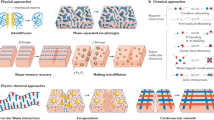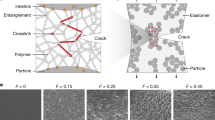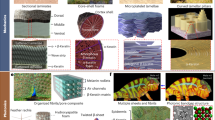Abstract
Our lives cannot be imagined without polymer networks, which range widely, from synthetic rubber to biological tissues. Their properties—elasticity, strain-stiffening and stretchability—are controlled by a convolution of chemical composition, strand conformation and network topology. Yet, since the discovery of rubber vulcanization by Charles Goodyear in 1839, the internal organization of networks has remained a sealed ‘black box’. While many studies show how network properties respond to topology variation, no method currently exists that would allow the decoding of the network structure from its properties. We address this problem by analysing networks’ nonlinear responses to deformation to quantify their crosslink density, strand flexibility and fraction of stress-supporting strands. The decoded structural information enables the quality control of network synthesis, comparison of targeted to actual architecture and network classification according to the effectiveness of stress distribution. The developed forensic approach is a vital step in future implementation of artificial intelligence principles for soft matter design.
This is a preview of subscription content, access via your institution
Access options
Access Nature and 54 other Nature Portfolio journals
Get Nature+, our best-value online-access subscription
$29.99 / 30 days
cancel any time
Subscribe to this journal
Receive 12 print issues and online access
$259.00 per year
only $21.58 per issue
Buy this article
- Purchase on Springer Link
- Instant access to full article PDF
Prices may be subject to local taxes which are calculated during checkout





Similar content being viewed by others
Data availability
All data supporting the findings are provided as figures and accompanying tables in the article and Supplementary Information. Data files for all figures are available from the corresponding authors on request.
References
Treloar, L. R. G. The Physics of Rubber Elasticity (Clarendon Press, 1975).
Flory, P. J. Principles of Polymer Chemistry (Cornell Univ. Press, 1971).
Sheiko, S. S. & Dobrynin, A. V. Architectural code for rubber elasticity: from supersoft to superfirm materials. Macromolecules 52, 7531–7546 (2019).
McKenna, G. B. Soft matter: rubber and networks. Rep. Prog. Phys. 81, 0666602 (2018).
Danielsen, S. P. O. et al. Molecular characterization of polymer networks. Chem. Rev. 121, 5042–5092 (2021).
Dossin, L. M. & Graessley, W. W. Rubber elasticity and well-characterized polybutadiene networks. Macromolecules 12, 123–130 (1979).
Patel, S. K., Malone, S., Cohen, C., Gillmor, J. R. & Colby, R. H. Elastic-modulus and equilibrium swelling of poly(dimethylsiloxane) networks. Macromolecules 25, 5241–5251 (1992).
Zhong, M., Wang, R., Kawamoto, K., Olsen, B. D. & Johnson, J. A. Quantifying the impact of molecular defects on polymer network elasticity. Science 353, 1264–1268 (2016).
Chase, W., Lang, M., Sommer, J.-U. & Saalwächter, K. Cross-link density estimation of PDMS networks with precise consideration of networks defects. Macromolecules 45, 899–912 (2012).
Chasse, W., Lang, M., Sommer, J.-U. & Saalwächter, K. Correction to cross-link density estimation of PDMS networks with precise consideration of networks defects. Macromolecules 48, 1267–1268 (2015).
Smith, S. B., Cui, Y. J. & Bustamante, C. Overstretching B-DNA: the elastic response of individual double-stranded and single-stranded DNA molecules. Science 271, 795–799 (1996).
Neuman, K. C., Lionnet, T. & Allemand, J. F. Single-molecule micromanipulation techniques. Ann. Rev. Mater. Res. 37, 33–67 (2007).
Flory, P. J. Network topology and the theory of rubber elasticity. Br. Polym. J. 17, 96–102 (1985).
Langley, N. R. Elasticity effective strand density in polymer networks. Macromolecules 1, 348–352 (1968).
Miller, D. R. & Macosko, C. W. New derivation of post gel properties of network polymers. Macromolecules 9, 206–211 (1976).
Sandakov, G. I., Smirnov, L. P., Sosikov, A. I., Summanen, K. T. & Volkova, N. N. NMR analysis of distribution of chain lengths between crosslinks of polymer networks. J. Polym. Sci. Polym. Phys. 32, 1585–1592 (1994).
Bastide, J. & Candau, S. J. in Physical Properties of Polymeric Gels (ed. Cohen, J. P.) 143−308 (Wiley, 1996).
Edwards, S. F. & Vilgis, T. A. The tube model theory of rubber elasticity. Rep. Prog. Phys. 51, 243–297 (1988).
Mullins, L. Determination of degree of crosslinking in natural rubber vulcanizates. Part IV. Stress-strain behavior at large extensions. J. Appl. Polym. Sci. 2, 257–263 (1959).
Vatankhah-Varnosfaderani, M. et al. Mimicking biological stress–strain behaviour with synthetic elastomers. Nature 549, 497–501 (2017).
Vatankhah-Varnosfaderani, M. et al. Chameleon-like elastomers with molecularly encoded strain-adaptive stiffening and coloration. Science 359, 1509–1513 (2018).
Rubinstein, M. & Colby, R. H. Polymer Physics (Oxford Univ. Press, 2003).
Dobrynin, A. V. & Carrillo, J.-M. Y. Universality in nonlinear elasticity of biological and polymeric networks and gels. Macromolecules 44, 140–146 (2011).
Panyukov, S. Loops in polymer networks. Macromolecules 52, 4145–4153 (2019).
Fetters, L. J., Lohse, D. J. & Colby, R. H. in Physical Properties of Polymers Handbook (ed. Mark, J. E.) 445–452 (Springer, 2007).
Staufer, D. Introduction to Percolation Theory (Taylor and Francis, 1985).
Ahmad, N. M., Lovell, P. A. & Underwood, S. M. Viscoelastic properties of branched polyacrylate melts. Polym. Int. 50, 625–634 (2001).
Daniel, W. F. M. et al. Solvent-free, supersoft and superelastic bottlebrush melts and networks. Nat. Mater. 15, 183–189 (2016).
Liang, H., Cao, Z., Wang, Z., Sheiko, S. S. & Dobrynin, A. V. Combs and bottlebrushes in a melt. Macromolecules 50, 3430–3437 (2017).
Liang, H., Wang, Z., Sheiko, S. S. & Dobrynin, A. V. Comb and bottlebrush graft copolymers in a melt. Macromolecules 52, 3942–3950 (2019).
Maw, M. et al. Brush architecture and network elasticity: path to the design of mechanically diverse elastomers. Macromolecules 55, 2940–2951 (2022).
Cao, Z., Carrillo, J.-M. Y., Sheiko, S. S. & Dobrynin, A. V. Computer simulations of bottle brushes: from melts to soft networks. Macromolecules 48, 5006–5015 (2015).
Carrillo, J.-M. Y., MacKintosh, F. C. & Dobrynin, A. V. Nonlinear elasticity: from single chain to networks and gels. Macromolecules 46, 3679–3692 (2013).
Peak, C. W., Wilker, J. J. & Schmidt, G. A review on tougth and sticky hydrogels. Colloid Polym. Sci. 291, 2031–2047 (2013).
Zhang, Y. S. & Khademhosseini, A. Advances in engineering hydrogels. Science 356, eaaf3627 (2017).
Peppas, N. A., Hilt, J. Z., Khademhosseini, A. & Langer, R. Hydrogels in biology and medicine: from molecular principles to bionanotechnology. Adv. Mater. 18, 1345–1360 (2006).
Acknowledgements
This work was supported by the National Science Foundation under grants DMR 1921835 (S.S.S., M.M.), DMR 1921923 (A.V.D., M.J.), DMR 2049518 (A.V.D., Y.T., M.J.) and DMR 2004048 (S.S.S., F.V.). E.A.N. and D.A.I. acknowledge the Ministry of Science and Higher Education of the Russian Federation for financial support in the frame of state contract no. 075-15-2022-1117 from June 30, 2022. A.V.D. and S.S.S. are grateful to E. Samulski for the critical reading of the manuscript and numerous stimulating discussions. We acknowledge the contribution of B. J. Morgan and A. N. Keith to the synthesis of well-defined PBA elastomers and linear–bottlebrush–linear copolymers, reported previously. E.A.N. and D.A.I. acknowledge the European Synchrotron Radiation Facility for provision of synchrotron beamtime at the ID02 beamline and thank the staff of the European Synchrotron Radiation Facility and E. A. Bersenev for assistance.
Author information
Authors and Affiliations
Contributions
A.V.D. developed the concept and theoretical foundation; F.V. and M.M. performed the synthesis, characterization and mechanical testing of brush networks; Y.T. analysed correlations between the network structure and mechanical properties; M.J. and Y.T. performed molecular dynamics simulations of polymer networks and analysed their properties; E.A.N. and D.A.I. performed X-ray scattering measurements; and A.V.D. and S.S.S. were the primary writers of the manuscript and the principal investigators. All authors discussed the results and provided feedback on the manuscript.
Corresponding authors
Ethics declarations
Competing interests
The authors declare no competing interests.
Peer review
Peer review information
Nature Materials thanks the anonymous reviewers for their contribution to the peer review of this work.
Additional information
Publisher’s note Springer Nature remains neutral with regard to jurisdictional claims in published maps and institutional affiliations.
Supplementary information
Supplementary Information
Supplementary Figs. 1–13, Tables 1–5, equations (1)–(21) and network synthesis and experimental protocols.
Rights and permissions
Springer Nature or its licensor (e.g. a society or other partner) holds exclusive rights to this article under a publishing agreement with the author(s) or other rightsholder(s); author self-archiving of the accepted manuscript version of this article is solely governed by the terms of such publishing agreement and applicable law.
About this article
Cite this article
Dobrynin, A.V., Tian, Y., Jacobs, M. et al. Forensics of polymer networks. Nat. Mater. 22, 1394–1400 (2023). https://doi.org/10.1038/s41563-023-01663-5
Received:
Accepted:
Published:
Issue Date:
DOI: https://doi.org/10.1038/s41563-023-01663-5
This article is cited by
-
Deciphering polymer networks
Nature Materials (2023)



